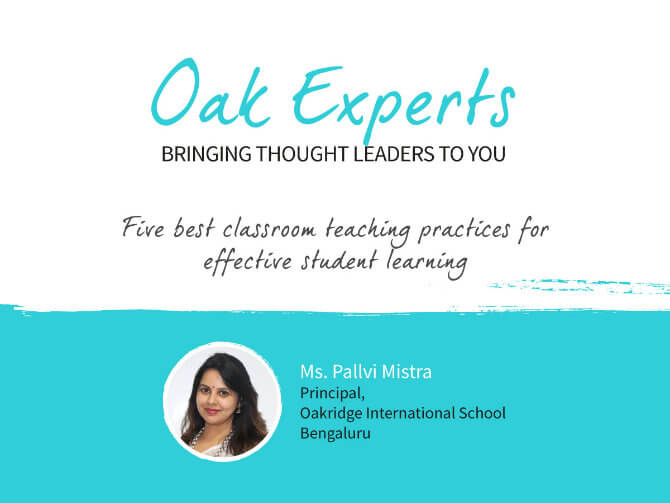Five best classroom teaching practices for effective student learning
- 12 June 2019


With a dynamic environment, the classroom brings together students from various abilities and personalities. To involve students in high-density reading and writing instruction, a teacher requires to have the ability to deal with each and meet students’ individual needs. Well, there is no one-size-fits-all solution to it. However, Ms. Pallavi Mishra, Principal at Oakridge, one of the best International Schools in Bengaluru brings in a set of best classroom teaching strategies to inspire your classroom practice.
Tip # 1: Begin with a short recap
For the purpose of continuity and learning that endures, I cannot stress enough on this practice. More importantly, don’t just repeat old info. Instead, a set of carefully planned and selected inquiry questions to put all the past lessons into context. This will give you an accurate picture of where your students stand and which areas need to be re-visited.
Tip #2: Use visual tools effectively
You may or may not have a smart board in your classroom, but as a teacher, you know the importance of visuals in creating an impact on learners. Many students don’t even process words but suddenly understand a complex idea through the right images. You can be creative and use permanent cut-outs, use slides, short videos and if nothing else go for the traditional listing method on a chalkboard. But do not skip this important step no matter which age group you are catering to.
Tip # 3: Group work
This practice is becoming popular in classes but is often poorly planned. The success of group work depends on (a) assigning the correct amount of time for the activity (b) providing the props required for it (c) Giving clear instructions (d) Balancing the capability levels in the various groups (e) Instant feedback after the group activity. Flip teaching is often misunderstood by both teachers and students. Assigning work without clear learning objectives and guided research can lead to a very superficial class.
Tip #4: Integrating technology
In a world where information is easily accessible to all, it is very boring for a student to sit through a PPT. which is only loaded with text and information. Teachers must not substitute the textbook with a slide. Instead use only an image, a keyword and a two-minute video to stimulate an insightful class debate. Planning it ahead and constantly revising and updating your tech material is vital.
Tip # 5: Academic Honesty
Unfortunately, many teachers do not role-model this valuable and indispensable virtue. Explain to students what amounts to plagiarism and how to write authentic work and cite sources. Teachers must work with a teacher librarian from Primary school level itself so that originality and student’s voice gets its due.
Principal at Oakridge International School, Bengaluru

Hyderabad, Gachibowli

Hyderabad, Bachupally

Visakhapatnam

Mohali
Bengaluru